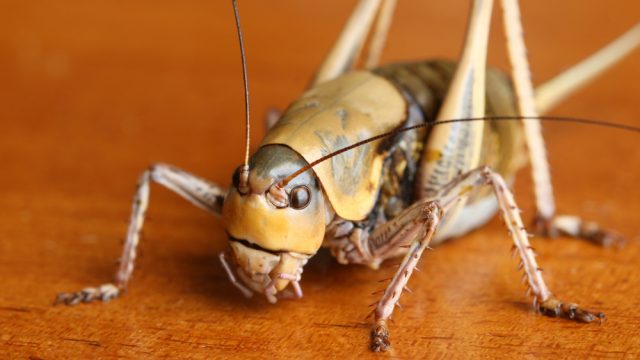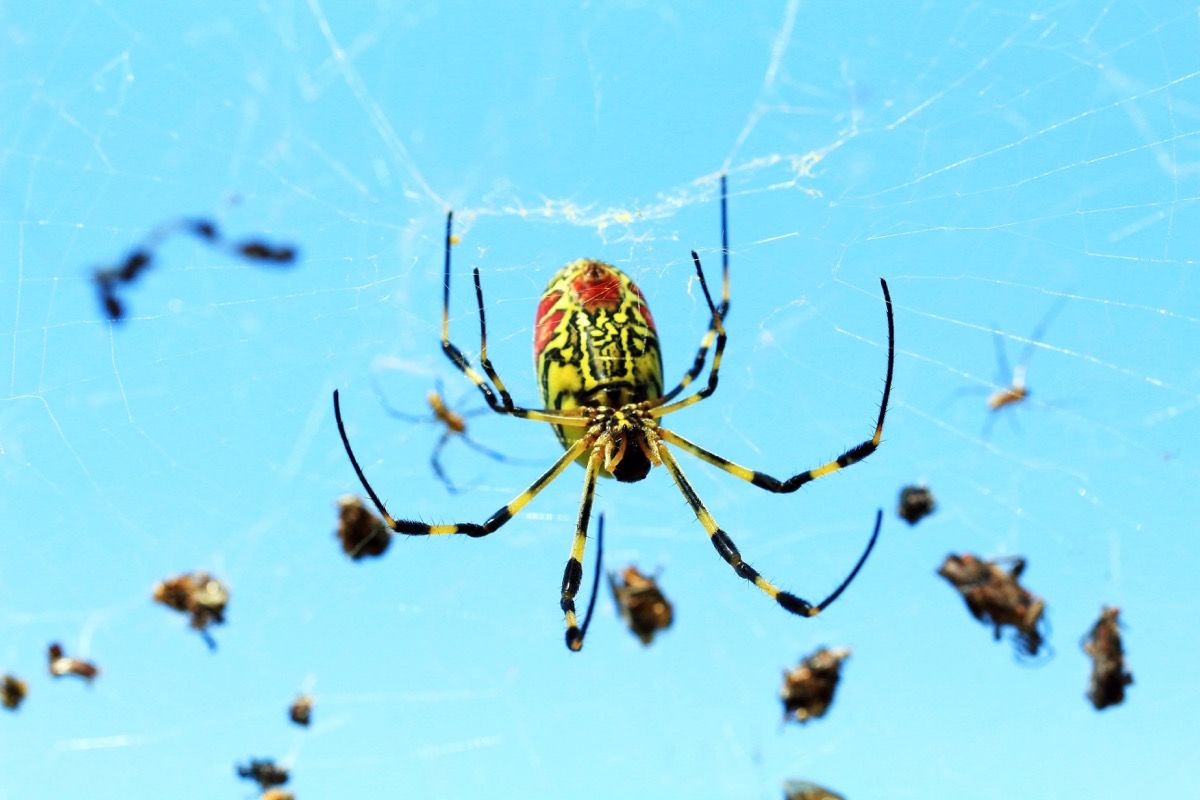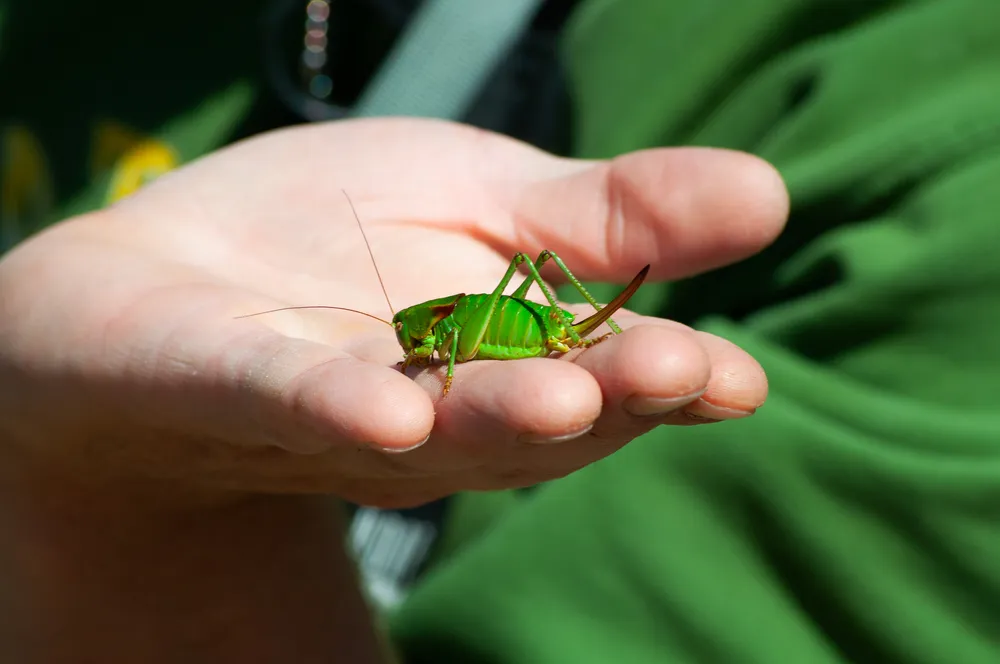If You Live Here, Prepare for “Biblical” Swarms of This Insect

Warm summer weather means the return of special activities like backyard barbecues, beach trips, and pool parties. Unfortunately, the heat also ushers in one major seasonal annoyance: pests. Of course, spending more time means you’re bound to encounter common bugs like mosquitos or ticks that you’ll want to avoid. But if you live in a particular area, you may be unable to stay away from an insect that’s arriving in “biblical” swarms. Read on to see if you can expect this pest in your state over the coming weeks.
READ THIS NEXT: If You See This Scary Bug in Your Home, Don’t Kill It, Experts Warn.
Some new invasive species have begun to spread quickly across the U.S.

It’s not just biting insects that are making moves lately. In some areas of the U.S., new types of invasive species are beginning to increase in numbers in their new habitats.
In the Southeastern U.S., palm-sized Joro spiders originally native to Japan have started to spread across the region, often traveling to new areas on the wind. Fortunately, the newly arrived arachnids don’t have a dangerous bite or pose a threat to local plants. They will likely do little to affect humans besides occasionally frightening them or even helping out by eating other obnoxious insects. However, experts warned that the conditions were right for them to expand their range all along the Eastern Seaboard due to a lack of natural predators.
The invasive spotted lanternfly is also making its seasonal comeback across the Northeast as its egg sacks start hatching and releasing new young. Unlike the Joro spider, these beautifully colored pests have swarmed and overwhelmed trees and fruit crops, causing concern among many officials that the bugs could lead to agricultural devastation if they continue to spread. But, elsewhere, another insect is expected to return in droves over the coming weeks.
Now, one area is bracing for “truly biblical” swarms of a devastating insect.

Officials in the Northwestern U.S. are bracing for another onslaught of giant insects known as Mormon crickets, the Associated Press reports. Even though the bugs are native to North America, unlike spotted lanternflies, they can grow to be about three inches in length and travel in “groups made up of millions or billions of individual insects and can migrate great distances,” according to the U.S. Department of Agriculture (USDA).
Swarms of the insects have been reported for centuries; they take their name from 19th-century Mormon settlers who had their crops destroyed by the pests. But experts now fear that climate change is causing their numbers to spike as conditions become drier and warmer, per the AP. And according to Skye Krebs, a rancher in Oregon, the latest swarms to hit his property have been “truly biblical.”
For more pest warnings sent right to your inbox, sign up for our daily newsletter.
State and federal officials are helping locals fight the oncoming wave of pests.

Both local and federal officials are anticipating a higher brood than usual in the coming weeks. Last year, the Oregon State Legislature voted to put $5 million towards suppressing the pests before signing over an additional $1.2 million weeks ago, the AP reports. Still, locals have also taken the fight against the insects into their own hands during the latest overwhelming swarms.
“I got the lawnmower out and I started mowing them and killing them,” April Aamodt, an Oregon resident nicknamed the “cricket queen,” told the AP. “I took a straight hoe and I’d stab them.”
Even with efforts in place, recent years have seen agricultural devastation due to the rising number of Mormon crickets. Last year, Oregon reported that more than 10 million acres of crops in the state were destroyed by the pests, per The Independent.
Some groups are concerned about the effects of using pesticides to fight Mormon crickets.

But the debate on how to combat the surging pest remains complicated. Environmental groups have opposed the broad pesticide spraying proposed and executed by USDA’s Animal and Plant Health Inspection Service (APHIS), arguing that the toxins can also kill off bugs that are vital to the food chain and harm populations of essential pollinators. As a result, the Xerces Society for Invertebrate Conservation and the Center for Biological Diversity (CBD) filed a lawsuit against APHIS, alleging the agency is damaging the local ecosystem and not considering alternatives to pesticides as a solution, per the AP.
“We’re very concerned about the impact of these broad, large sprays to our grassland and rangeland ecosystems,” Sharon Selvaggio, the Xerces Society’s Pesticide Program Specialist, told the AP.
But for the time being, locals are still gearing up for the arrival of their longtime foe. And while Aamodt has pointed out that previous years saw landowners in the area turn to pesticide alternatives such as wrapping trees in duct tape as a trap and bringing in goats to graze, many realize that outcome will depend on how much hands-on assistance there is to go around.
“Keep in mind that these are people that are taking time out from their own lives to do this,” Jordan Maley, an Oregon State University Extension Agent, told the AP. “The volunteers made a huge difference.”